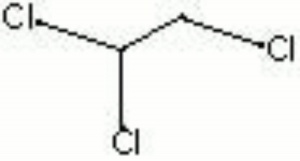Difference between revisions of "Trichloroethane, 1,1,2-"
Jump to navigation
Jump to search
(username removed) |
|||
| (3 intermediate revisions by 2 users not shown) | |||
| Line 1: | Line 1: | ||
== Description == | == Description == | ||
| − | Colorless, sweet-smelling liquid. 1,1,2-trichloroethane is used as a [ | + | Colorless, sweet-smelling liquid. 1,1,2-trichloroethane is used as a [[solvent|solvent]] for [[fat|fats]], [[oil|oils]], [[wax|waxes]], [[natural%20resin|resins]], and [[polymer|polymers]]. |
| − | + | [[[SliderGallery rightalign|trichloroethane, 1,1,2-.jpg~Chemical structure]]] | |
== Synonyms and Related Terms == | == Synonyms and Related Terms == | ||
vinyl trichloride; beta-chloroethane; beta-trichloroethane | vinyl trichloride; beta-chloroethane; beta-trichloroethane | ||
| − | + | == Risks == | |
| + | |||
| + | * Nonflammable but decomposed with heat to produce toxic fumes. | ||
| + | * Skin contact causes irritation. | ||
| + | * Potential carcinogen. | ||
| + | * Inhalation or ingestion may cause nausea, heart arrhythmia, headaches, liver damage. | ||
| + | * Fisher Scientific: [https://fscimage.fishersci.com/msds/26380.htm MSDS] | ||
| − | == | + | ==Physical and Chemical Properties== |
Soluble in ethanol, ethers, esters, ketones. Insoluble in water. | Soluble in ethanol, ethers, esters, ketones. Insoluble in water. | ||
| Line 22: | Line 28: | ||
|- | |- | ||
! scope="row"| Melting Point | ! scope="row"| Melting Point | ||
| − | | -36.4 | + | | -36.4 C |
|- | |- | ||
! scope="row"| Density | ! scope="row"| Density | ||
| − | | 1.4432 | + | | 1.4432 g/ml |
|- | |- | ||
! scope="row"| Molecular Weight | ! scope="row"| Molecular Weight | ||
| Line 34: | Line 40: | ||
|- | |- | ||
! scope="row"| Boiling Point | ! scope="row"| Boiling Point | ||
| − | | 113.7 | + | | 113.7 C |
|} | |} | ||
| − | == | + | ==Resources and Citations== |
| − | |||
| − | |||
| − | |||
| − | |||
| − | |||
| − | |||
| − | |||
| − | |||
| − | * | + | * Richard S. Lewis, ''Hawley's Condensed Chemical Dictionary'', Van Nostrand Reinhold, New York, 10th ed., 1993 |
| − | * | + | * Michael McCann, ''Artist Beware'', Watson-Guptill Publications, New York City, 1979 |
* ''The Merck Index'', Martha Windholz (ed.), Merck Research Labs, Rahway NJ, 10th edition, 1983 Comment: entry 9767 | * ''The Merck Index'', Martha Windholz (ed.), Merck Research Labs, Rahway NJ, 10th edition, 1983 Comment: entry 9767 | ||
Latest revision as of 11:58, 16 June 2022
Description
Colorless, sweet-smelling liquid. 1,1,2-trichloroethane is used as a Solvent for fats, oils, waxes, resins, and polymers.
Synonyms and Related Terms
vinyl trichloride; beta-chloroethane; beta-trichloroethane
Risks
- Nonflammable but decomposed with heat to produce toxic fumes.
- Skin contact causes irritation.
- Potential carcinogen.
- Inhalation or ingestion may cause nausea, heart arrhythmia, headaches, liver damage.
- Fisher Scientific: MSDS
Physical and Chemical Properties
Soluble in ethanol, ethers, esters, ketones. Insoluble in water.
| Composition | CHCl2CH2Cl |
|---|---|
| CAS | 79-00-5 |
| Melting Point | -36.4 C |
| Density | 1.4432 g/ml |
| Molecular Weight | mol. wt.=133.4 |
| Refractive Index | 1.4458-1.4711 |
| Boiling Point | 113.7 C |
Resources and Citations
- Richard S. Lewis, Hawley's Condensed Chemical Dictionary, Van Nostrand Reinhold, New York, 10th ed., 1993
- Michael McCann, Artist Beware, Watson-Guptill Publications, New York City, 1979
- The Merck Index, Martha Windholz (ed.), Merck Research Labs, Rahway NJ, 10th edition, 1983 Comment: entry 9767
